Written by: Rik
Date posted: July 8, 2008
Note – like some of our other ‘brief history’ features, this was written some time ago. While it may not be completely up-to-date, hopefully it still covers the period featured fairly accurately. I’m hoping to revise and update soon, but until then, here’s the feature, as it was, whenever it was written!
Update: It’s not exactly a like-for-like replacement, but we do now have The FFG Football League, a feature which organises our coverage of football games into a league table.
1987
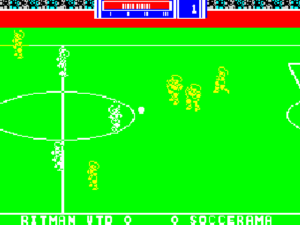 Jon Ritman’s Match Day 2 (pictured) becomes the first universally acclaimed footy title. Available for 8-bit stalwarts the C64, Spectrum and CPC, it offered no real teams or players and was as slow as hell, but the fact that it was well coded put it light years ahead of the competition.
Jon Ritman’s Match Day 2 (pictured) becomes the first universally acclaimed footy title. Available for 8-bit stalwarts the C64, Spectrum and CPC, it offered no real teams or players and was as slow as hell, but the fact that it was well coded put it light years ahead of the competition.
Elsewhere, desperate attempts to cash in on Mexico ’86 included Peter Shilton’s ‘Handball Maradona!’ (no kidding) and U.S Gold’s World Cup Carnival, possibly the worst football game ever, receiving chronically low marks (including one of zero) across the board.
1988
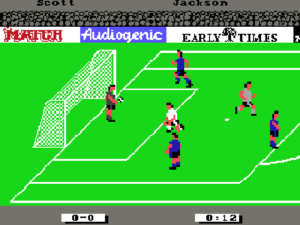 Match Day 2 reigns supreme on the 8-bit formats until the arrival of Emlyn Hughes’ International Soccer (pictured). Aside from providing international teams, leagues, cups and even a pseudo-management feature, it also played the best game of football seen thus far, taking MD2 as its template and improving on it in every respect.
Match Day 2 reigns supreme on the 8-bit formats until the arrival of Emlyn Hughes’ International Soccer (pictured). Aside from providing international teams, leagues, cups and even a pseudo-management feature, it also played the best game of football seen thus far, taking MD2 as its template and improving on it in every respect.
Meanwhile, Dino Dini’s Kick Off arrives on the ST and Amiga and quickly establishes itself as the game of choice.
1990
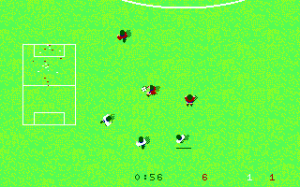 World Cup time, and another slew of mediocre titles, including the similarly titled World Cup: Italia 1990 and Italy 1990.
World Cup time, and another slew of mediocre titles, including the similarly titled World Cup: Italia 1990 and Italy 1990.
However, by far and away the best title to emerge in this year is Kick Off 2 (pictured), adding subtlety to its predecessor’s fast and furious gameplay, including the opportunity to ‘bend’ shots and passes. Still no sign of real teams or players, though.
1991
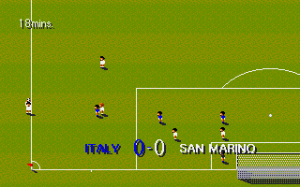 The top-down view pioneered by Kick Off spawns numerous imitators, including one called Sensible Soccer (pictured). Essentially a stilted version of Kick Off 2, it isn’t very good, but quickly catches on and dominates the market for years to come.
The top-down view pioneered by Kick Off spawns numerous imitators, including one called Sensible Soccer (pictured). Essentially a stilted version of Kick Off 2, it isn’t very good, but quickly catches on and dominates the market for years to come.
In its favour, it was the first title to offer comprehensive league and cup options with real teams and players, all fully customisable. The success of several seasonal updates proves that this sort of thing really does make a difference.
1993
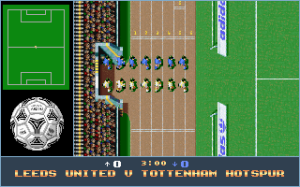 Dino Dini’s long-awaited Goal! (pictured) finally arrives, fusing the classic Kick Off gameplay with the teams, options and customisability of Sensi. Though critically acclaimed, it was largely ignored by the masses, probably because they were too busy playing Sensible Soccer.
Dino Dini’s long-awaited Goal! (pictured) finally arrives, fusing the classic Kick Off gameplay with the teams, options and customisability of Sensi. Though critically acclaimed, it was largely ignored by the masses, probably because they were too busy playing Sensible Soccer.
Meanwhile, a new game called FIFA International Soccer arrives on the Sega Megadrive. Essentially a limp and uncontrollable game disguised by (then) jaw-dropping graphics, lots of people get rather carried away.
1994
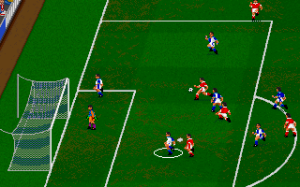 The good name of Kick Off is sullied by the disastrous Kick Off 3, a woeful side-on effort with uncontrollable players.
The good name of Kick Off is sullied by the disastrous Kick Off 3, a woeful side-on effort with uncontrollable players.
The European Challenge update (pictured), arriving a year later, improves things slightly but the series gradually withers away with its original creator no longer present.
1995
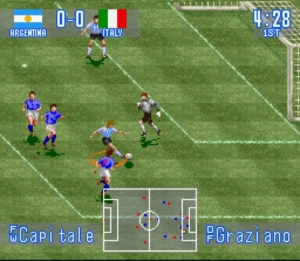 With the Amiga and ST fading fast, and the world still waiting for the PSX and Saturn, lots of people buy PCs, no doubt persuaded by the presence of several ground-breaking games such as Doom, Magic Carpet and TIE Fighter. However, as far as football games are concerned, a sub-standard conversion of Sensible World of Soccer reigns supreme until the genre goes 3D and early titles (notably Actua Soccer and FIFA ’96), while flawed, show promise.
With the Amiga and ST fading fast, and the world still waiting for the PSX and Saturn, lots of people buy PCs, no doubt persuaded by the presence of several ground-breaking games such as Doom, Magic Carpet and TIE Fighter. However, as far as football games are concerned, a sub-standard conversion of Sensible World of Soccer reigns supreme until the genre goes 3D and early titles (notably Actua Soccer and FIFA ’96), while flawed, show promise.
However, the connoisseur’s choice is International Superstar Soccer (pictured) on the SNES, a slick side-scroller offering the most complete simulation of the game yet.
1996
Gremlin callously re-release Actua Soccer as Euro ’96, replete with all the annoying bugs that plagued the original. Games magazines get annoyed and give it a bit of a panning. FIFA ’97 arrives on the scene and looks very nice, but plays like a wet fish. While the PSX is already giving the Saturn a good kicking, it still lacks a decent football title, and purists briefly embrace Sega Worldwide Soccer.
1997
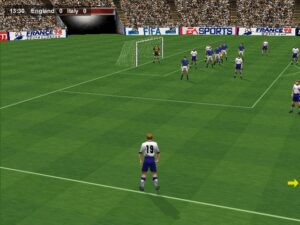 The ISS franchise splits two ways, with Konami Osaka responsible for giving the original ISS a 3D outing on the N64, while the Tokyo team work on an all-new title for the PSX, ISS Pro. While both are very good, the proven pedigree of ISS 64 sees it hailed as ‘the best football game ever’.
The ISS franchise splits two ways, with Konami Osaka responsible for giving the original ISS a 3D outing on the N64, while the Tokyo team work on an all-new title for the PSX, ISS Pro. While both are very good, the proven pedigree of ISS 64 sees it hailed as ‘the best football game ever’.
On the PC, things get a little bit better with the release of FIFA: Road to the World Cup ’98 (pictured), boasting jaw-dropping graphics and much-improved gameplay. Gremlin’s Actua Soccer 2 is fast, furious, and (finally) devoid of stupid goalkeepers, but is nothing like the sport it purports to simulate.
Meanwhile, hidden gem Puma World Football ’98 is released, and the world shrugs.
1998
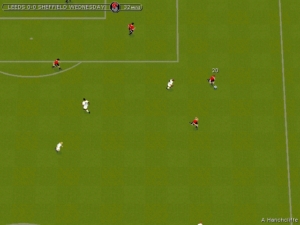 EA finally corners the PC market with a slick World Cup tie-in. Essentially a spruced-up version of FIFA ’98, it is enough to win over doubting Actua fans, although some still stick doggedly to Sensible Soccer, a new 3D version of which (pictured) is released this year.
EA finally corners the PC market with a slick World Cup tie-in. Essentially a spruced-up version of FIFA ’98, it is enough to win over doubting Actua fans, although some still stick doggedly to Sensible Soccer, a new 3D version of which (pictured) is released this year.
Though there is praise for the new Sensi, it soon becomes clear that it’s neither a decent game nor a faithful update of the original. Fortunately, LiveMedia release Total Soccer which unashamedly references earlier top-down football titles.
A slew of average also-rans are released on PC, including World League Soccer ’98 and Kick Off ’98, among others. On the consoles, the ISS games get an update, with the N64 version (marginally) still the title of choice. Towards the end of the year, EA release the cunningly-titled FIFA ’99 and Eidos repackage World League Soccer with Michael Owen on the box. Actua Soccer 3 arrives but doesn’t measure up to FIFA.
1999
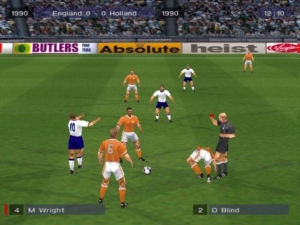 With FIFA now firmly established on the PC, EA decide to stop putting as much effort into their new games. Having secured the official Premier League license, it releases FA Premier League STARS, a bizarre Premiership-only affair that boasts up-to-the-minute kits and stadia but plays like something from several years ago. FIFA 2000 is better but graphics aside is worryingly similar to last year’s effort.
With FIFA now firmly established on the PC, EA decide to stop putting as much effort into their new games. Having secured the official Premier League license, it releases FA Premier League STARS, a bizarre Premiership-only affair that boasts up-to-the-minute kits and stadia but plays like something from several years ago. FIFA 2000 is better but graphics aside is worryingly similar to last year’s effort.
Elsewhere, Virgin’s Viva Football (pictured) eventually emerges, over six months late, but regrettably unfinished (and it’s a bit crap as well). Microsoft bury the memory of their first footballing effort (the laughable Microsoft Soccer) by hijacking Rage’s UEFA Striker from the Dreamcast and releasing it as the not-bad-really International Football 2000.
2000
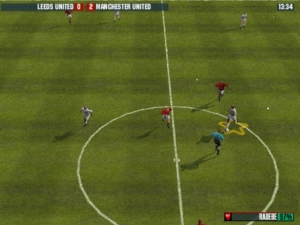 EA release three football games this year, Euro 2000, Premier League Stars 2001 (pictured) and FIFA 2001. None of them are all that much different from last year’s releases. Aside from the Champions League tie-in (using a recycled World League Soccer engine), there is little else to speak of on the PC. On the PSX, however, ISS Pro Evolution arrives and blows everything else away, including the still-very-good ISS 2000 on the N64, later converted to the Playstation.
EA release three football games this year, Euro 2000, Premier League Stars 2001 (pictured) and FIFA 2001. None of them are all that much different from last year’s releases. Aside from the Champions League tie-in (using a recycled World League Soccer engine), there is little else to speak of on the PC. On the PSX, however, ISS Pro Evolution arrives and blows everything else away, including the still-very-good ISS 2000 on the N64, later converted to the Playstation.
[EDIT: I didn’t include football management games in this article when I first wrote it. However, the venerable Championship Manager series is worth a mention. The first version was released back in 1993 and it’s still going strong under the name Football Manager].
2001
EA show willing by scrapping FA Premier League STARS, and delivering a slightly different version of FIFA with an all-new passing system. Although some see this as a welcome sign of initiative, it actually makes the game worse. A couple of new games arrive on the PC: UEFA Challenge, a messy amalgamation of Actua Soccer and International Football 2000, and European Superleague, a thinly-disguised version of Viva Football. Both are largely unplayable. ISS Pro Evolution 2 pushes the ageing PSX to its limits and retains its crown comfortably until Pro Evolution Soccer arrives on the PS2.
2002
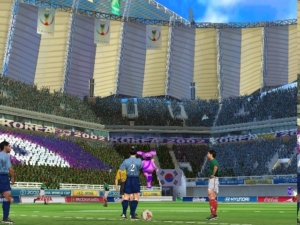 EA re-hash FIFA 2002 in time for the World Cup, and the result (pictured) is a horrendous mess of a game, though one with all the official team kits, stadiums and player faces. On PS2, Pro Evolution Soccer 2 is pure brilliance, while the more-arcadey ISS 2 is somewhat less so. Kick Off 2002 appears on the PC, and fails to justify its £8 price tag. Despite the debacle of the World Cup license, EA spring a surprise by producing one of the better FIFA games for some time in FIFA 2003.
EA re-hash FIFA 2002 in time for the World Cup, and the result (pictured) is a horrendous mess of a game, though one with all the official team kits, stadiums and player faces. On PS2, Pro Evolution Soccer 2 is pure brilliance, while the more-arcadey ISS 2 is somewhat less so. Kick Off 2002 appears on the PC, and fails to justify its £8 price tag. Despite the debacle of the World Cup license, EA spring a surprise by producing one of the better FIFA games for some time in FIFA 2003.
2003
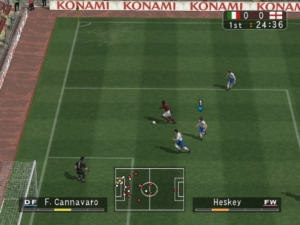 Codemasters release Club Football, the same game repackaged 16 times, each tailored to supporters of one of Europe’s top clubs. The game isn’t bad and it certainly looks authentic, but ultimately it fails to match the likes of Pro Evolution Soccer 3 (pictured), which also secures a PC release, although you really need a PS2 joypad to play it properly. FIFA 2004 promises much, but is actually a step backwards from last year’s effort. Lots of people buy it anyway.
Codemasters release Club Football, the same game repackaged 16 times, each tailored to supporters of one of Europe’s top clubs. The game isn’t bad and it certainly looks authentic, but ultimately it fails to match the likes of Pro Evolution Soccer 3 (pictured), which also secures a PC release, although you really need a PS2 joypad to play it properly. FIFA 2004 promises much, but is actually a step backwards from last year’s effort. Lots of people buy it anyway.
2004
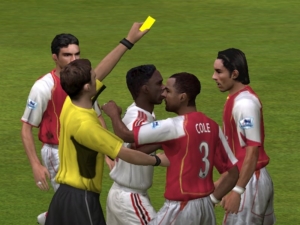 EA admit that Euro 2004 won’t match Pro Evo for gameplay, but promise that it will deliver the authentic Euro 2004 experience. If that experience is hollow disappointment (it is for England fans) then it certainly succeeds. With other competitors falling by the wayside, the football scene is largely dominated by the yearly battle between EA and Konami. Pro Evolution 4 arrives, boasting not only the improved gameplay we’ve come to expect, but also additional licensing and celebrity endorsements, as well as a multi-format release. FIFA 2005 (pictured) can’t touch it.
EA admit that Euro 2004 won’t match Pro Evo for gameplay, but promise that it will deliver the authentic Euro 2004 experience. If that experience is hollow disappointment (it is for England fans) then it certainly succeeds. With other competitors falling by the wayside, the football scene is largely dominated by the yearly battle between EA and Konami. Pro Evolution 4 arrives, boasting not only the improved gameplay we’ve come to expect, but also additional licensing and celebrity endorsements, as well as a multi-format release. FIFA 2005 (pictured) can’t touch it.


 Posts
Posts